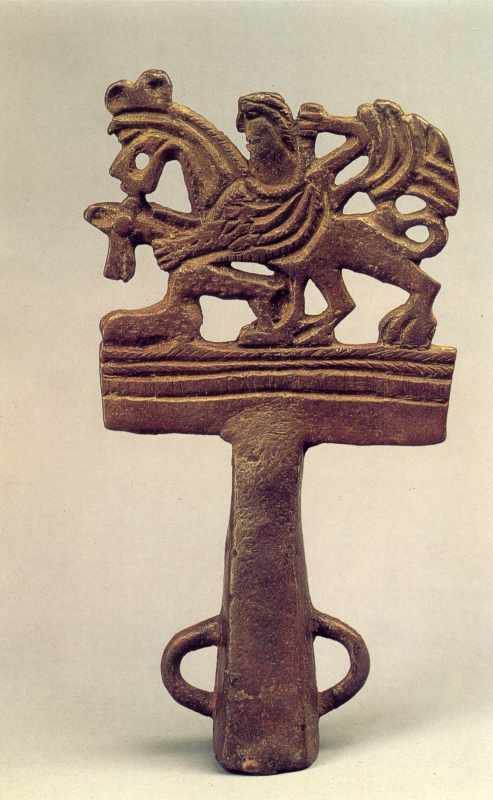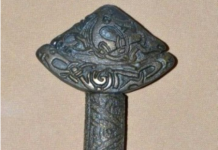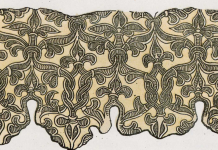“According to the Scythians, theirs is the youngest of all nations, and it came into existence in the following way. The first man born in this land, when it was still uninhabited, was named Targitaos. They say that the parents of this Targitaos were Zeus and the daughter of the River Borysthenes…” (Herodotus, 4.5)
Scholars point out that Targitaos in this legend is an autochthonous person in the sense that he is indigenous rather than descended from migrants or colonists. And that his mother is the River Dnieper/ Borysthenes.
[Explanation of the term ‘Ukrainian’ used in the heading. Wikipedia insists that the Scythians are “an ancient Eastern Iranic equestrian nomadic people who had migrated during the 9th to 8th centuries BC from Central Asia”. At the same time, the very term ‘Iran’ came into circulation only in the 3rd century A.D., or simply put, more than 1,200 years after the alleged migration. But as we have just read in Herodotus, the Scythians called themselves “a nation” and believed that they descended directly from their legendary forefather Targitaos, who was born in their land, then a wilderness, to divine parents – Zeus and the daughter of the Dnieper River, the central river of Ukraine. Using the term ‘Ukrainian’ similar to scholars using the term ‘Iranian’ simplifies geographic location perception. Because it is important to realize that for the Scythians, the origin of their nation, their sacred homeland was in the area of present-day Ukraine, and not in any other place. They would surely have told Herodotus if they had been migrants from Asia or the Near East.]
Herodotus even mentions the time when Targitaos was born: “They say that the entire interval between the birth of their race and the reign of their first king, Targitaos, and Darius’ crossing over to their land was no more than 1,000 years” (Herodotus, 4. 7). Since the invasion of Darius the Great into European Scythia took place in 513 B.C., the birth of Targataos can be set at approximately 1,500 B.C. It is yet another argument against the alleged migration theoryof the Iranian tribes in the 9th century B.C.)
Doctor of History Dmitriy Raevskiy (1941-2004) who specialized in Scythian archaeology expressed some interesting views on Targitaos:
“The main male deity was Targitaus, the forefather of all the Scythians and the founder of their royal dynasty. Legends about Targitaus are so amazingly similar to the heroic exploits of Heracles that many classical Greek authors preferred to call Targitaus by the Greek name. The stone-carved statues that once surmounted the burial mounds of the Scythian royal dynasty are thought to have represented Targitaus. In the minor arts, the most popular were the scenes that depicted Targitaus wrestling with a lion or with some monstrous fantastic beast…
The three sons of Targitaos – Lipoxais, Arpoxais, and Kolaxais – became the progenitors of the three big Scythian families. The brothers had to pass the ordeals sent to them by the gods: gold objects fell from heaven in front of them: a plough with a yoke, an axe, and a cup. The sons of Targitaos tried to pick them up, but the gold flared in flames when the first two brothers approached, whereas when the youngest brother, Kolaxais, approached, the flames died down. Taking this to be an omen, the two older brothers recognized the predominance of Kolaxais and he became the progenitor of the Scythian kings…
Here we are confronted with an interesting detail: the second narrative of Herodotus contains evidence that a gold cup (phiale) was attached to the belt of Herakles and that this marked the beginning of the Scythian tradition of wearing a cup on one’s belt. From the first version of the myth, we know that such a cup was a priestly attribute. However, in the trials of Herakles’ sons, the cup plays no role: the victor receives it somewhat automatically, having proved that he is a warrior. Therefore, in addition to the sacred object for a warrior and the royal power, the youngest son of Herakles-Targitaos receives the priestly cup as well, and with this the right to perform the functions of a priest…
B.N.Grakov drew attention to the abundance of gold appliques decorated with the image of Herakles fighting against the lion in Scythian barrows, and he launched the hypothesis that the Scythians perceived them as personifications of their own mythical progenitor, Targitaos, fighting against and defeating some monster. The assumption put forward earlier that in Scythian mythology the predator stood for the chthonic world, the world of death, correlates well with such an interpretation. Actually, these images reflect the idea of overcoming death, which was so important in the system of notions of Scythian society. Of analogous significance here were the images of the victory of the Scythian-looking figure over the griffins, the scene of the fight against the dragonlike predator, decorating the comb from Gaymanovaya barrow, as well as the scene decorating the standard from Slonovskava Bliznitsa [title image of the article].”
The “Royal Scythia, Greece, Kyiv Rus” book has more facts about Ukraine being the central area of the former Scythia.










